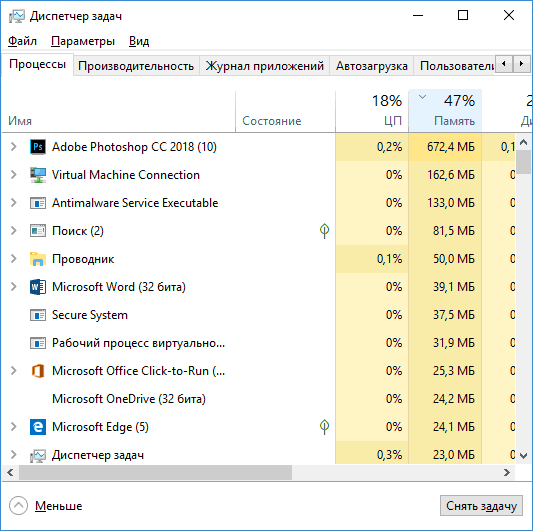Рассказываем, как открыть диспетчер задач в Windows и что делать, если привычные методы не работают.
Функции
Как открыть
Альтернативные методы
Не открывается
Доступ запрещен
Функции
Как открыть
Альтернативные методы
Не открывается
Доступ запрещен

Если компьютер начал тормозить, первое, что стоит сделать — запустить менеджер процессов. Он помогает увидеть, какие приложения запущены сейчас, сколько они потребляют ресурсов и что нагружает программное обеспечение. Это ключ к управлению системой.
Инструмент часто нужен в тот момент, когда система зависает и перестает реагировать на команды. Поэтому полезно знать разные способы открыть диспетчер задач в Windows. Делимся подборкой методов и разбираемся, почему средство мониторинга может не открываться. Выясняем, как вернуть к нему доступ.
Функции диспетчера задач
Если утилита перестает открываться, это не просто неудобство, а серьезное ограничение в управлении Windows. Пользователь теряет инструмент контроля, поскольку диспетчер задач — это не только список процессов.
Вот что позволяет делать менеджер.
-
Следить за тем, какие процессы перегружают систему и могут снижать производительность.
-
Завершать работу зависших или конфликтующих между собой приложений.
-
Принудительно завершать зависшие процессы программ, которые не закрылись корректно.
-
Просматривать активные приложения и фоновые процессы.
-
Отслеживать нагрузку на процессор, оперативную память, диск, сеть и видеокарту.
-
Управлять автозагрузкой программ при старте системы.
-
Просматривать список активных пользователей и уровень их нагрузки на систему.
-
Вручную запускать новые задачи.
-
Получать подробную информацию о каждом процессе — от пути к файлу до цифровой подписи.
-
Принудительно закрывать вредоносные программы или нестабильные процессы.
Как быстро открыть диспетчер задач на компьютере
Самые простые и надежные способы, которых в большинстве случаев вполне достаточно.
1. Горячие клавиши
Нажмите одновременно горячие клавиши Ctrl + Shift + Esc. Пока клавиатура работает без сбоев и система хоть немного откликается, этот метод станет вашим главным способом.

2. Экран безопасности
Нажмите комбинацию Ctrl + Alt + Del. В появившемся служебном меню выберите пункт диспетчер задач. Эта легендарная комбинация, вошедшая в поп-культуру, выручает, например, во время игр, которые не дают использовать стандартное Ctrl + Shift + Esc. Комбинация будет работать, поскольку имеет приоритет над большинством процессов. После ее ввода можно заблокировать компьютер, сменить пользователя, выйти из системы, перезагрузить или перевести компьютер в режим ожидания.

3. Меню «Пуск»
Кликните по кнопке «Пуск» и начните вводить в поисковом окне диспетчер задач или Task Manager.

4. Панель задач
Щелкните правой кнопкой мыши по пустому месту на панели задач и выберите пункт диспетчер задач в открывшемся меню.

5. Панели управления
Нажмите [Windows] + S и введите диспетчер задач или Task Manager.

6. Win + X меню
Щелкните правой кнопкой по иконке «Пуск» или нажмите [Windows] + X. Удобный вариант, особенно если клавиатура не работает и приходится пользоваться мышью. Меню опытного пользователя содержит множество полезных инструментов — в том числе и диспетчер задач.
Альтернативные методы открытия диспетчера задач
В некоторых ситуациях стандартные варианты бывают недоступны. Например, если приложение блокирует работу горячих клавиш. Тогда на помощь приходят альтернативные методы.
1. Диалоговое окно Win + R
Нажмите [Windows] + R, в диалоговом окне введите taskmgr и нажмите OK.

2. Проводник
Откройте любой каталог в Проводнике, впишите taskmgr в адресную строку и подтвердите.

3. Командная строка
Нажмите [Windows] + R, введите cmd и нажмите Enter. В открывшейся командной строке наберите taskmgr и снова подтвердите ввод кнопкой Enter. Это не самый быстрый путь, но он выручит, если, например, не работает Проводник или вы уже находитесь в терминале.

4. Запуск исполняемого файла вручную
У диспетчера задач есть свой .exe-файл, как у любого другого приложения.
-
Откройте Проводник.
-
Перейдите в папку C:\Windows\System32.
-
Найдите файл с именем Taskmgr и запустите его двойным щелчком.
Если файлов в папке много, проще вбить имя в строку поиска. А если Windows установлена не на диске C, просто замените букву на ту, где находится система.

Другой вариант: введите адрес C:\Windows\System32\ в строке поиска Проводника, чтобы напрямую получить доступ к местоположению утилиты.

Что делать, если диспетчер задач не открывается
Если утилита в Windows не открывается вообще — ни с клавиатуры, ни через поиск, ни каким-либо другим способом — скорее всего, система столкнулась со сбоем. Он может быть вызван поврежденными файлами, действиями вредоносного программного обеспечения или некорректной работой интерфейса.
Первое, что стоит сделать — проверить систему на вирусы. Некоторые вредоносные программы намеренно деактивируют диспетчер задач, чтобы скрыть свою активность.
Если с безопасностью все в порядке, проверьте целостность системных файлов. Прежде чем перейти к следующим шагам и вносить серьезные изменения в систему, создайте точку восстановления системы и сделайте резервную копию важных данных.
Для этого потребуется запустить командную строку от имени администратора и ввести команду sfc /scannow. Система начнет сканирование и автоматически исправит найденные ошибки. Иногда программа не запускается из-за неправильных записей в реестре. Если вы уверены, что причина в этом, отредактируйте соответствующие ключи самостоятельно.
Иногда проблема связана не с системой в целом, а с конкретной учетной записью. В таком случае стоит попробовать создать нового пользователя и проверить, откроется ли интерфейс мониторинга там. Если все работает, значит, дело в настройках или повреждениях профиля, и возможно, имеет смысл перенести данные на созданный аккаунт.
Если ни один из этих способов не помогает, возможно, повреждения системы слишком серьезные. Тогда потребуется восстановление Windows — через встроенные средства или с установочного носителя.
Как восстановить диспетчер задач после отключения администратором
Если утилита отключена администратором, при попытке ее открыть появляется сообщение, что доступ запрещен. Это бывает сделано намеренно — например, в организациях, где пользователям ограничивают возможности управления системой. Но если вы уверены, что блокировка неуместна или появилась после сбоя, ее возможно снять.
Один из способов — через изменение системного реестра.
-
Откройте окно «Выполнить» комбинацией [Windows] + R и введите команду regedit.
-
В редакторе перейдите в HKEY_CURRENT_USER\Software\Microsoft\Windows\CurrentVersion\Policies\System.
-
Если в правой части окна есть параметр DisableTaskMgr, его значение, скорее всего, установлено в 1 — это и блокирует программу.
-
Поменяйте значение на 0 или удалите параметр совсем, после чего перезагрузите систему. Если параметра нет — можно ничего не трогать. Просто проверьте, не задан ли он.
Будьте осторожны с корректировками в реестре — лучше не менять ничего лишнего.
Иногда блокировка задается через групповую политику. Если у вас есть права администратора, откройте редактор локальной групповой политики.
-
Нажмите [Windows] + R и напишите gpedit.msc.
-
В открывшемся окне перейдите в «Конфигурация пользователя», затем — «Административные шаблоны», «Система».

-
Выберите раздел «Параметры Ctrl + Alt + Del». Там есть настройка «Удалить диспетчер задач».

-
Убедитесь, что она отключена или не задана — тогда система больше не будет мешать запуску инструмента.

После внесения этих изменений менеджер процессов должен снова открываться без ограничений. Если этого не происходит, стоит перезагрузить компьютер и проверить еще раз.
В этой инструкции для начинающих 8 способов открыть диспетчер задач Windows 10. Сделать это не сложнее, чем в предыдущих версиях системы, более того, появились и новые методы для открытия диспетчера задач.
Базовая функция диспетчера задач — отображение информации о запущенных программах и процессах и используемых ими ресурсах. Однако, в Windows 10 диспетчер задач все время совершенствуется: теперь там можно отслеживать данные по загрузке видеокарты (раньше только процессора и оперативной памяти), управлять программами в автозагрузке и не только это. Подробнее о возможностях в статье Диспетчер задач Windows 10, 8 и Windows 7 для начинающих.
8 способов запустить диспетчер задач Windows 10
Теперь подробно обо всех удобных способах открыть диспетчер задач в Windows 10, выбирайте любой:
- Нажмите Ctrl + Shift + Esc на клавиатуре компьютера — сразу запустится диспетчер задач.
- Нажмите Ctrl + Alt + Delete (Del) на клавиатуре, а в открывшемся меню выберите пункт «Диспетчер задач».
- Нажмите правой кнопкой мыши по кнопке «Пуск» или клавиши Win+X и в открывшемся меню выберите пункт «Диспетчер задач».
- Нажмите правой кнопкой мыши в любом пустом месте панели задач и выберите «Диспетчер задач» в контекстном меню.
- Нажмите клавиши Win+R на клавиатуре, введите taskmgr в окно «Выполнить» и нажмите Enter.
- Начните вводить «Диспетчер задач» в поиск на панели задач и запустите его оттуда, когда он будет найден. Также можно использовать поле поиска в «Параметры».
- Зайдите в папку C:\Windows\System32\ и запустите файл taskmgr.exe из этой папки.
- Создайте ярлык для запуска диспетчера задач на рабочем столе или где-то ещё, в качестве объекта указав файл из 7-го способа запуска диспетчера задач.
Думаю, этих способов будет более чем достаточно, если только вы не столкнетесь с ошибкой «Диспетчер задач отключен администратором».
Как открыть диспетчер задач — видео инструкция
Ниже — видео с описанными способами (разве что 5-й почему-то забыл, а потому получилось 7 способов запуска диспетчера задач).
Думаю, продемонстрированных вариантов будет достаточно для решения задачи.
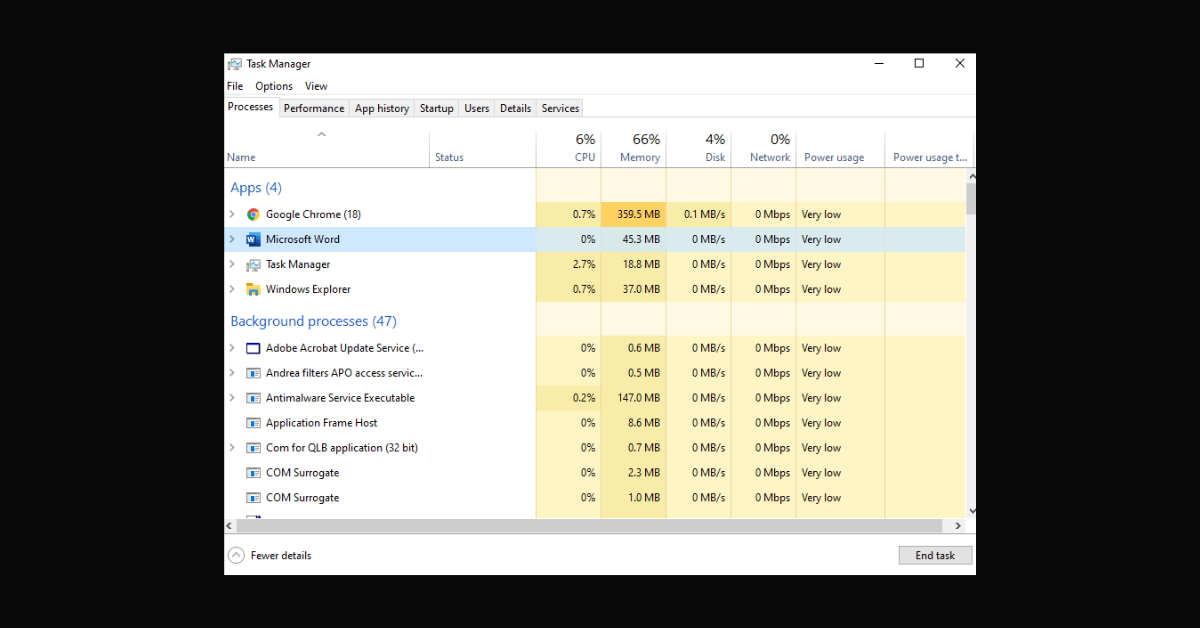
Windows Task Manager is an advanced utility tool that helps you manage your apps that are running.
Task Manager lets you see which apps are open and which you’re using. You can also see which apps are running in the background that you didn’t open yourself.
One important reason that you might want to open Task Manager is to stop apps that are making windows unresponsive.
There are a few different ways to open Task Manager. So in this article, I will walk you through 7 ways you can open Task Manager on Windows 10.
1. How to Open Task Manager with Windows Search
The easiest way to find anything on a Windows machine is to search for it. Task Manager is not an exception.
- Click on the search icon then type «Task Manager» in the search bar.
- Task Manager will pop up as a search result, and you can open it from there.

2. How to Open Task Manager with Keyboard Shortcuts
Some apps might go rogue and stop Windows from responding, so you might not have access to Windows Search in such situations.
Windows has two different key combinations with which you can open up Task Manager in case you want to see running apps or stop an app.
- You can open Task Manager by pressing
Ctrl + Shift + Escall together. This opens Task Manager straightaway - You can also open Task Manager from the GINA screen by pressing and holding
Ctrl + Alt + Del.
Some apps might prevent you from accessing Task Manager with Ctrl + Shift + Esc, but pressing Ctrl + Alt + Del will always open up the Graphical Identification and Authentication (GINA) screen for you so you can select and open Task Manager from there.
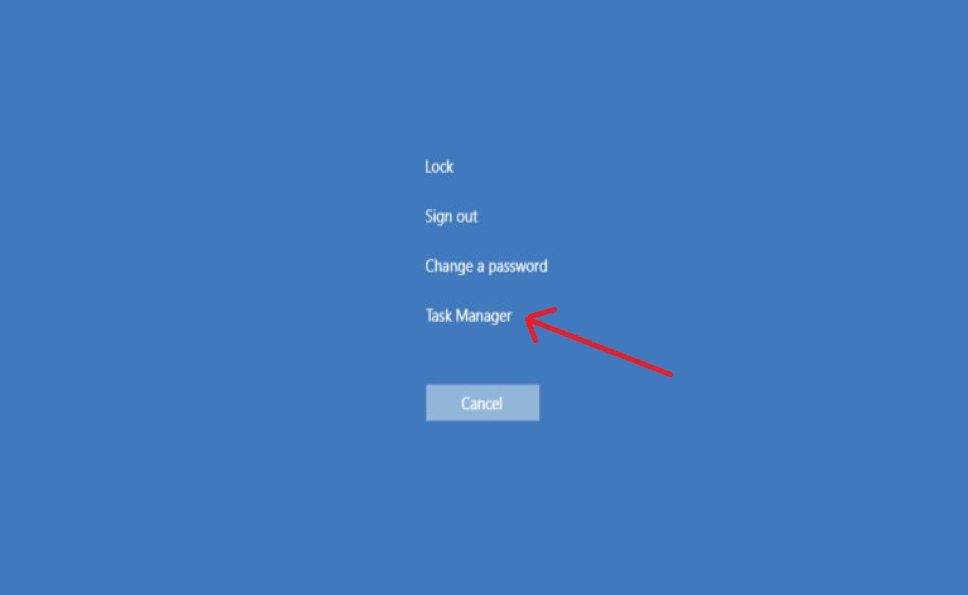
3. How to Open Task Manager through the Control Panel
You can use the Control Panel search option to open Task Manager.
Type «Task Manager» in the search bar and you will see a link to Task Manager under «System».

A lot of people prefer opening apps from the start menu. You can open Task Manager from there too.
- Click on the Windows icon, or press the
WINKey on the keyboard. - Scroll to the bottom and open up the Windows system folder
- Task Manager will be shown alongside some other apps – just select it there to open it.
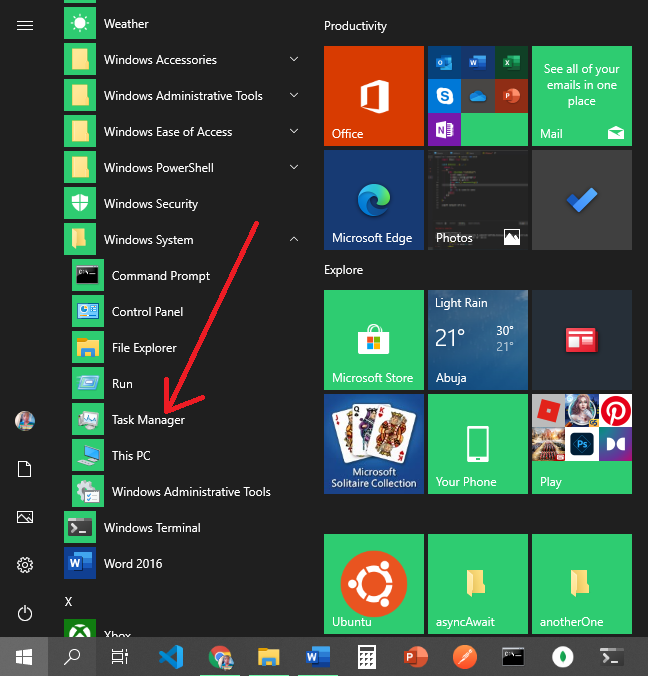
5. How to Open Task Manager with the Run Command
Many apps and folders can be opened with the run dialogue on Windows 10. There’s a command for opening Task Manager from there too.
- Press the
WIN + Rkeys on the keyboard to open the run dialogue - Type «taskmgr» and click «Ok» to open the Task Manager.
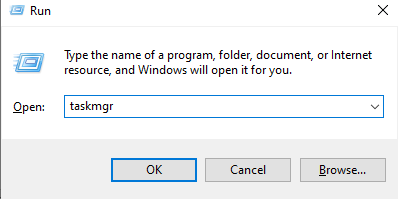
6. How to Open Task Manager from the Taskbar
You can open the Task Manager from Taskbar too.
Right-click on an empty space in the taskbar then select «Task Manager».
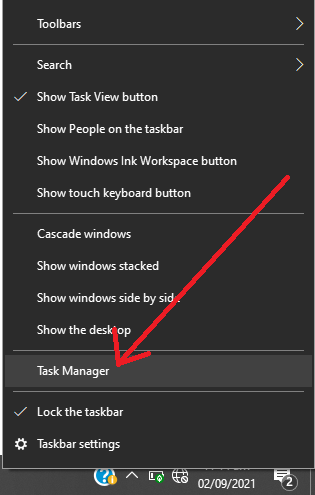
In addition to the 6 methods we’ve already seen, you can open Task Manager by right-clicking in the Windows logo and then selecting «Task Manager» from the menu that pops up.
You can also get there by pressing and holding the Win + X keys on the keyboard and then selecting “Task Manager” from the menu.
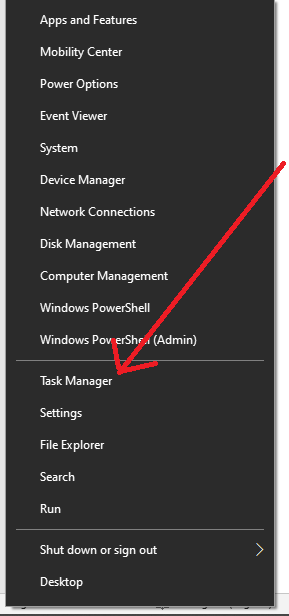
Conclusion
Windows Task Manager is a very powerful tool that can greatly increase your productivity. With it, you can see which apps are running and stop those that are causing issues.
In this article, you’ve learned about several ways to open Task Manager on Windows 10 so you can have a better experience using it.
Thank you for reading, and have a nice time.
Learn to code for free. freeCodeCamp’s open source curriculum has helped more than 40,000 people get jobs as developers. Get started
Wondering how to open Task Manager in Windows quickly? Whether you’re using Windows 10 or Windows 11, there are multiple ways to access this crucial tool to monitor system performance, manage processes, and troubleshoot issues.
11 Ways To Open Task Manager
This guide will show you 11 different ways to open Task Manager in Windows 10/11, ranging from Task Manager shortcuts to using commands. Learning these methods ensures you can easily launch Task Manager regardless of the situation.
Table of Content
- 11 Ways To Open Task Manager
- Method 1: Open Task Manager Using Keyboard Shortcut (Ctrl + Shift + Esc)
- Method 2: Open Task Manager Using Second Keyboard Shortcut (Ctrl + Alt + Delete)
- Method 3: Open Task Manager Using Power User Menu (Win+X)
- Method 4: Open Task Manager Using Run Window
- Method 5: Open Task Manager Using Command Prompt
- Method 6: Open Task Manager Using The Search Bar
- Method 7: Open Task Manager Using Taskbar Menu
- Method 8: Open Task Manager Using Control Panel
- Method 9: Open Task Manager by Creating a Desktop Shortcut
- Method 10: Pin Task Manager to the Taskbar
- Method 11: Open Task Manager Using File Manager
Method 1: Open Task Manager Using Keyboard Shortcut (Ctrl + Shift + Esc)
Here, we need to again press three keys simultaneously. In this case, we need to press the Ctrl + Shift + Esc button at the same time. This will directly open the Task Manager. In this way, we can able to bypass the five options which are coming there in the previous method.
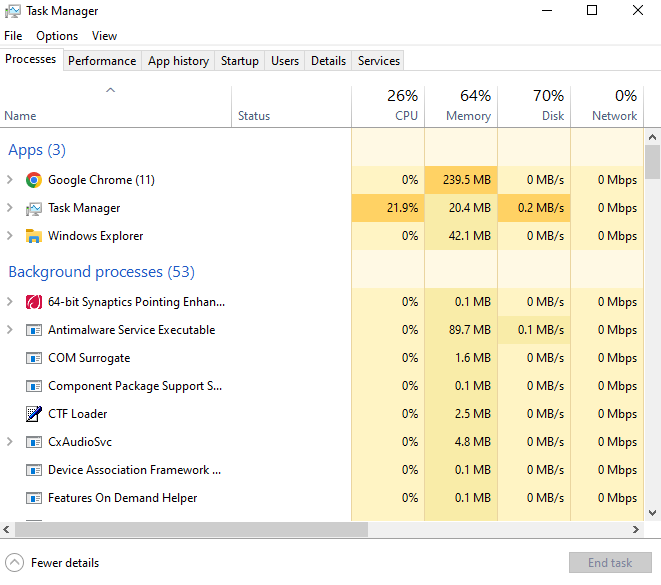
Hence, we have opened the Task Manager using a keyboard shortcut.
Method 2: Open Task Manager Using Second Keyboard Shortcut (Ctrl + Alt + Delete)
Step 1: At first, users need to press three keys simultaneously. Users need to press Ctrl + Alt + Delete. Pressing all these three buttons will help to open a new window in front of the users.
Step 2: Users will find three options there. Among them, users need to click on the Task Manager option to open it.

Step 3: When users click over it, they will find the Task Manager is now opened in front of the users. Now, they can perform anything there.
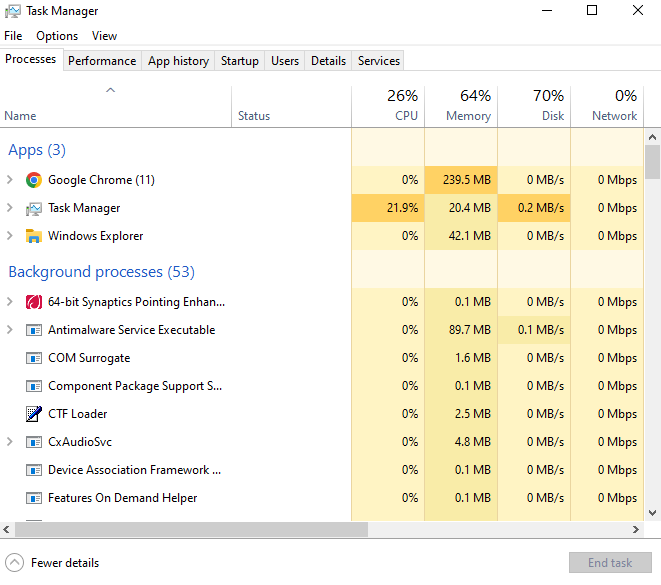
Hence, we have opened the Task Manager using one another keyboard shortcut.
Step 1: Simply Open the Power User Menu by pressing Window + X.
Step 2: Now, select Task Manager from the list.
You can also do this by pressing Win+X and the list of options will appear, Press T to open Task Manager


Step 3: In the next stage, the Task Manager will promptly open in front of the users.
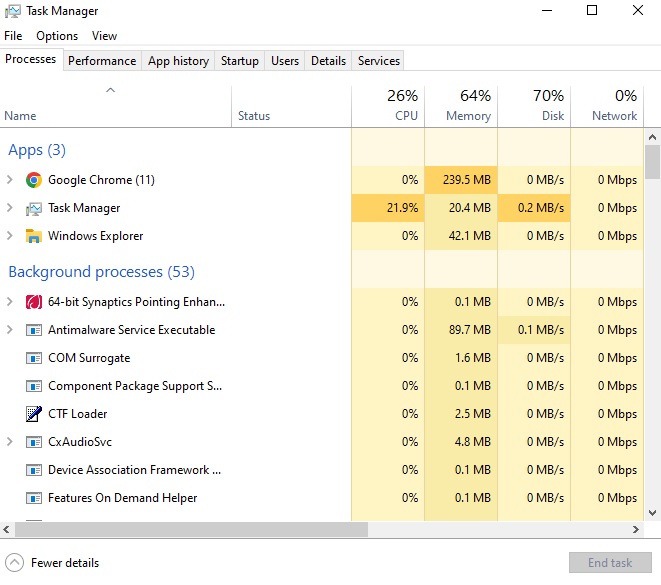
Hence, we have opened the Task Manager using the Taskbar.
Method 4: Open Task Manager Using Run Window
Step 1: Open Run Dialog Box using Windows + R keys.
Step 2: Then in the run window, type the “taskmgr”. Now, Click OK to move ahead.
Step 3: Now, users will find the Task Manager window opened in front of the users.
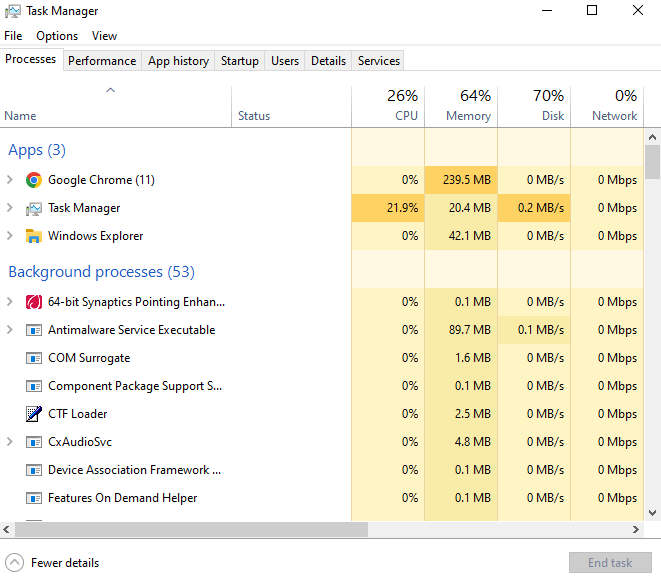
Hence, we have opened the Task Manager using the Run command window.
Method 5: Open Task Manager Using Command Prompt
Step 1: Open Command Prompt on your Windows PC and execute the following command.
Taskmgr

Step 2: In the next step, the Task Manager will appear on the screen of the machine.

Hence, we have opened the Task Manager using Command Prompt.
Method 6: Open Task Manager Using The Search Bar
Step 1: In the Taskbar, users will find the search bar that is placed beside the Windows sign. Users need to click on that & write down the Task Manager there. It might show the Task Manager symbol or might not. Depending upon the performance of the machine this might happen. Users just need to Press Enter.
Step 2: It will just open the Task Manager for more operation on it if users need to do so.

Hence, we have opened the Task Manager using the Search Bar.
Step 1: Right Click on the space in the Taskbar and select Task Manager
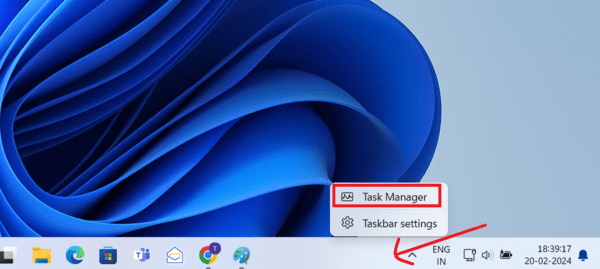
The Task Manager will appear on the screen of your computer PC.
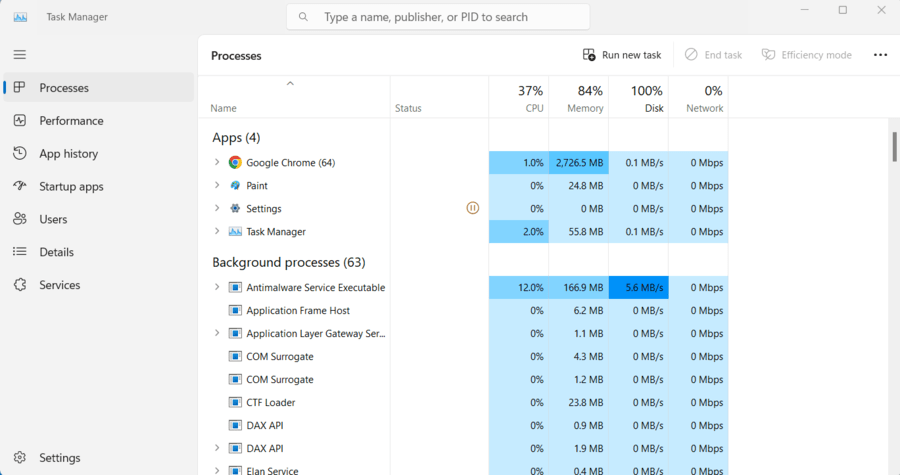
Method 8: Open Task Manager Using Control Panel
Step 1: Press the Win key to open the search bar and type control panel, Open it.
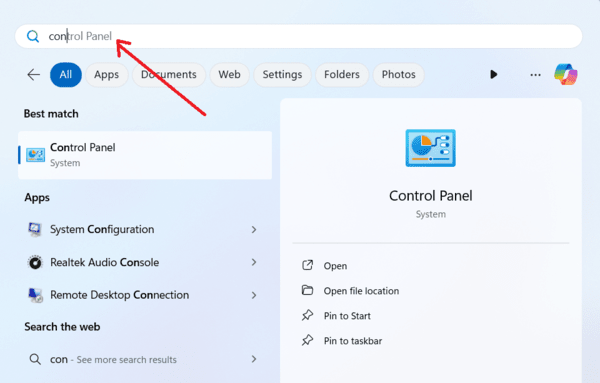
Step 2: Now type Task Manager in the search bar, and a direct link to open Task Manager will be generated. Click the link to open Task Manager.
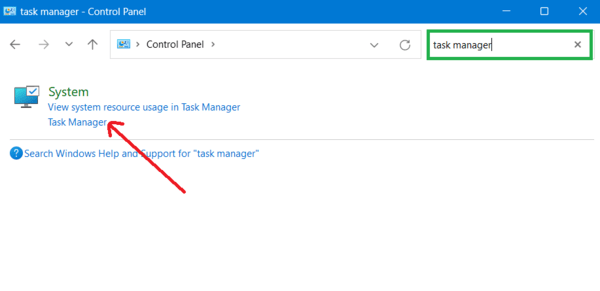
The Task Manager will appear on the screen of your computer PC.
Method 9: Open Task Manager by Creating a Desktop Shortcut
Step 1: Right-click on the space on the desktop and select New > Shortcut.
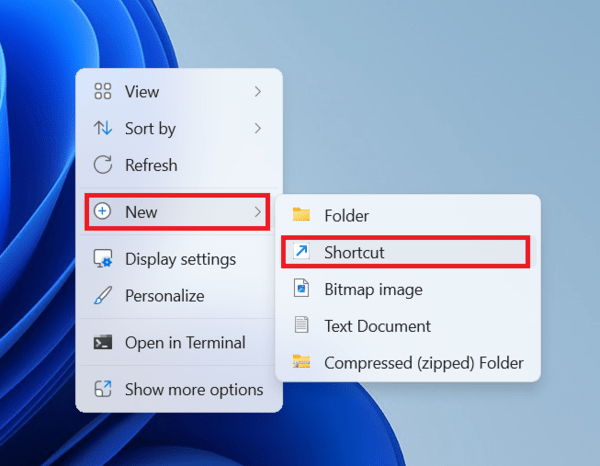
Step 2: Now type the location of the item, simply type taskmgr.exe, and click Next.
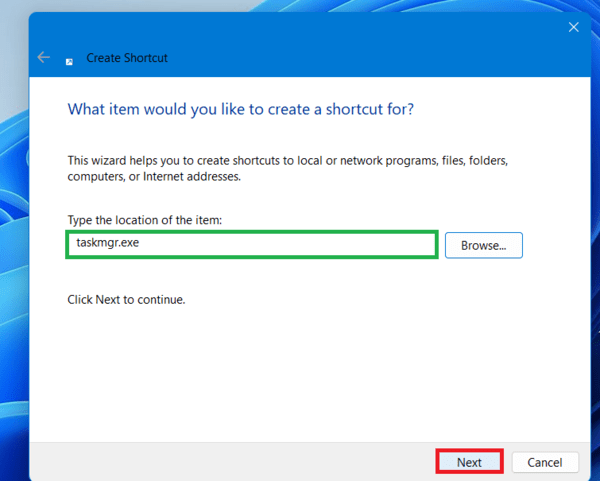
Step 3: Provide a name for your shortcut like Task Manager and click Finish.
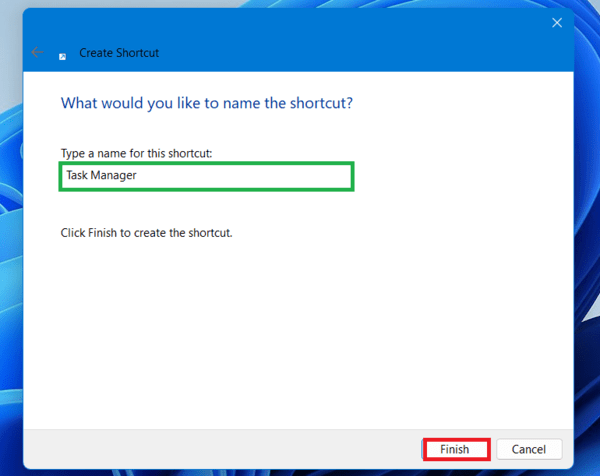
The Task Manager desktop shortcut is created and will appear on your Windows desktop. Double-click to open Task Manager directly from the desktop at any time.
Method 10: Pin Task Manager to the Taskbar
If you require Task Manager you must add it to the taskbar for quick access. For this pin Task Manager uses the following steps.
Step 1: Open Task Manager using any of the above-mentioned methods.
Step 2: Now, right-click on the Task Manager icon present on the Taskbar and select PIN to Taskbar.

Now you can access Task Manager quickly from Taskbar.
Method 11: Open Task Manager Using File Manager
Step 1: First, users need to open the C Drive of their machine. Users will find some folders present there. Among them, users need to click on the Windows folder & open it.

Step 2: In the Windows folder, users need to scroll down more & they will find a folder called System32. Users need to click on it & open that folder.

Step 3: Now, inside that folder, users need to search for the “Tskmgr”. The folder will show one or more options with that name. Users need to click on the Application file to open the Task Manager.

Step 4: After clicking on that, users will find the Task Manager in front of them.

Hence, we have opened the Task Manager using File Manager.
Note: This is the most lengthy, slow & hectic process ever to open the Task Manager. It is advisable to use any of the above methods to quickly open the Task Manager. If users need to waste their time by using this relatively long method, then they can surely go through it.
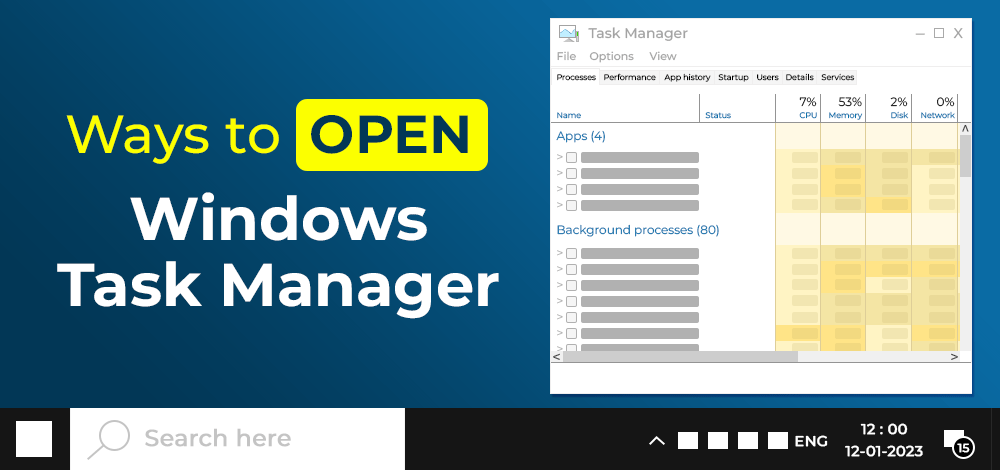
11 Ways To Open Task Manager in Windows 10/11
Conclusion
Mastering the various methods to open Task Manager in Windows 10/11 will make system monitoring and troubleshooting more efficient. Whether you prefer using the Task Manager keyboard shortcuts or accessing it through the Command Prompt, these methods provide flexibility. Now, with these different ways to open Task Manager, you can choose whichever option fits your workflow best and ensure quick access when needed.
Also Read
- How to Enable End Task Option on Windows 11 Taskbar?
- How to Hide Taskbar in Windows 10?
- How to Make the Taskbar Transparent in Windows 11?
Download Article
Fast and easy ways to see running apps and services in Windows
Download Article
- Ctrl + Shift + Esc
- Ctrl + Alt + Del
- Taskbar Menu
- Power User Menu
- Windows Search
- Control Panel
- Run Dialog Box
- Command Prompt
- File Explorer
- Pin to the Taskbar
- Make a Desktop Shortcut
- Video
- Q&A
- Tips
|
|
|
|
|
|
|
|
|
|
|
|
|
Trying to open the Windows Task Manager to end a process or check your computer’s performance? The Task Manager allows you to view various activities that occur on your PC. You can monitor running applications, CPU and RAM usage, startup apps (Windows 8 and 10 only), and services. You can also end unresponsive or frozen applications! This wikiHow article will show you various ways to open the Task Manager in Windows 8, Windows 10, and Windows 11, including quick keyboard shortcuts.
Things You Should Know
- Press Ctrl + Shift + Esc to immediately open the Task Manager.
- Alternatively, right-click the Taskbar and select «Task Manager» to open it.
- You can also press Windows Key + X to open the Power User menu and select «Task Manager.»
-
This keyboard shortcut will open the Task Manager in a new window.
- You’re ready to look through your processes and end tasks! Clearing tasks that you don’t need to run is a great way to speed up a slow Windows computer.
Advertisement
-
This will open the Windows Security screen.[1]
-
If you’re running an older Windows version, it might be listed as Start Task Manager. This will open the Task Manager in a new window.
Advertisement
-
The taskbar is the bar running along the bottom of the screen that contains your Start menu. Doing so will show a context menu.
-
Advertisement
-
It’s located at the lower-left corner of your screen. This brings up the Power User Menu.
- You can also press ⊞ Win+x together to do this.
-
This will open the Task Manager in a new window.
- Alternatively, press the T keyboard key.
Advertisement
-
Follow these steps depending on your Windows version:[2]
-
-
This will open the Task Manager in a new window.
Advertisement
-
This method uses the built-in Control Panel app to open the Task Manager.
-
This will open the Control Panel in a new window.[3]
-
This will show you a list of results related to the task manager.
-
It’s under the «System» section of the search results. You’re done! The Task Manager will open in a new window.
Advertisement
-
Press ⊞ Win+R together.
-
[4]
-
This will open the Task Manager in a new window.
Advertisement
-
Open Command Prompt or Windows PowerShell. This can be done by searching for the respective application and selecting it from the results.
-
You should see copyright text at the top and your user folder path.
-
[5]
-
This will open the Task Manager in a new window.
Advertisement
-
-
-
-
-
It might have «.exe» at the end of the name depending on your file viewing settings.
- You’ll need to scroll down past the folders, which are always placed at the top.
Advertisement
-
-
-
-
-
It might have «.exe» at the end of the name depending on your file viewing settings.
- You’ll need to scroll down past the folders, which are always placed at the top.
-
This will open an options menu.[6]
-
This will make it so that the Task Manager always appears in the Taskbar, even when it’s closed. You can click the Task Manager icon to reopen it.
Advertisement
-
-
-
-
-
It might have «.exe» at the end of the name depending on your file viewing settings. An options menu will appear.
- You’ll need to scroll down past the folders, which are always placed at the top.
-
This will create a desktop shortcut for the Task Manager.[7]
- In Windows 11, you may need to click Show more options to access the Create shortcut option.
-
This will open the Task Manager in a new window.
Advertisement
Add New Question
-
Question
Is it normal for a redundancy (17x) of «Microsoft Windows System Protection Background Tasks» to be running all the time?
No that is not normal. This process is very taxing on the CPU processor of your computer. If it is running this test consistently then it probably means your Windows Operating System has corrupted files and you would need to do a fresh install of the operating system. You can also try to boot it in safe mode and try some trouble shooting there. If that doesn’t work, back up your data in safe mode and bring your computer to a repair shop instead of sending it back to the manufacturer.
-
Question
My Windows 10 system keeps saying my computer is locked because my IP address is being used without my knowledge that contains websites that can steal my identity and that contain identity theft.
-
Question
Windows 10 keeps saying: «The code cannot proceed because AppVlsvSubsystems32.dll was not found.» I tried to reinstall the program but my computer still isn’t working. What can I do to fix this?
Try downloading AppVlsvSubsytems32.dll and put it in your system and system32 folders. If this fails, then you probably need a new Windows installation.
Ask a Question
200 characters left
Include your email address to get a message when this question is answered.
Submit
Advertisement
Thanks for submitting a tip for review!
Advertisement
Video
About This Article
Thanks to all authors for creating a page that has been read 601,056 times.

